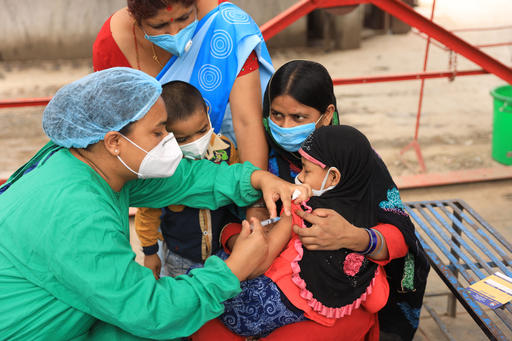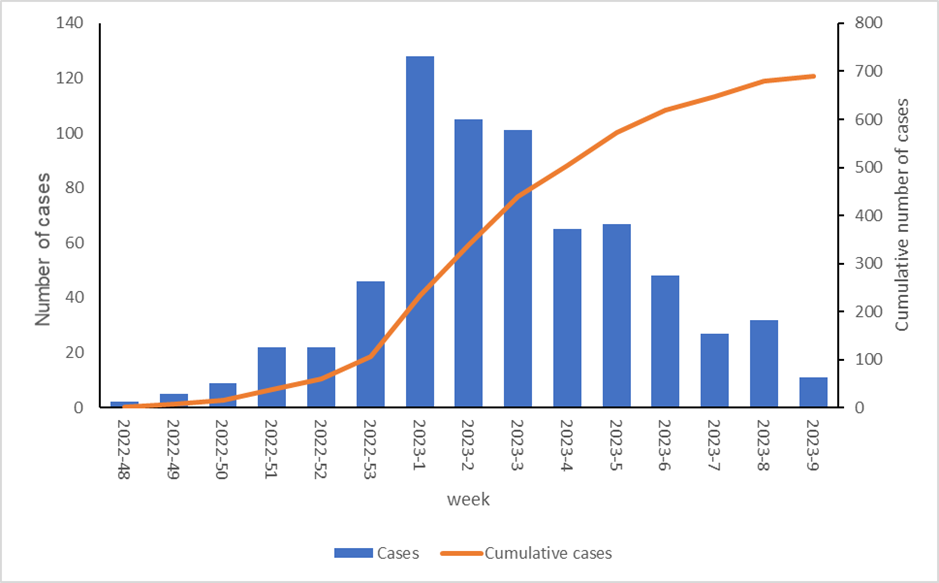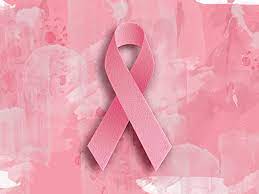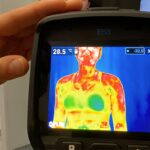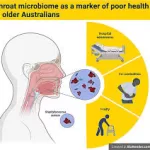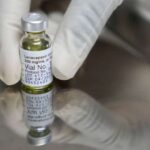Measles – Nepal
As shown in Figure-1, the number of cases increased sharply in the last week of December but started declining in the second week of January and continues to show a declining trend.
Figure 2: Distribution of measles cases (n= 690) reported by district in Nepal between 24 November 2022 to 10 March 2023
The majority of cases (n=591; 86%) have been less than 15 years old. However, nine measles cases have also been observed in the older age group (≥ 45 years) with the maximum age of a case being 73 years.
Figure 3: Age distribution and vaccination status of measles cases in Nepal from 24 November 2022 to 10 March 2023
Epidemiology of measles
Public health response
The Ministry of Health (MoH), with support from WHO, partners and non-governmental organizations (NGOs), have implemented response measures. These include:
- Ongoing active case search and line listing of fever and rash cases. Vitamin A is administered to those identified with fever and rash.
- The mobilization of health personnel including health care workers (HCW), local NGOs, and technical staff from WHO, UNICEF, the District Public Health Office, and the health unit of Nepalgunj SMC to implement response measures.
- The launch of non-selective ORI on 6 January 2023 by Nepalgunj SMC, targeting children aged six months to 15 years. As of 6 February, a total of 153 485 children have been vaccinated with one dose of the measles-rubella (MR) vaccine. ORI is being conducted in Nepalgunj SMC (with a target of 100% coverage) and adjoining municipalities (including Khajura, Narainapur, Duduwa, Janki, Raptisenari, Baijanath, and Kohalpur).
- Ongoing non-selective ORI with the MR vaccine in Banke and Kailali districts for children aged between six months and 15 years. The government plans to expand this ORI response to other affected/high-risk districts of western Nepal.
- Strengthening measles surveillance and mobilization of the district rapid response team (RRT) in Banke district.
- Ensuring an adequate stock of vaccines and logistics, as well as medicines for supportive treatment, are available at the provincial and federal governments in case of urgent need.
WHO risk assessment
While measles is endemic in Nepal and is reported every year, the magnitude and extent of the current outbreak are unusually high compared to the previous years. Only sporadic isolated measles cases have occurred since 2004, when a substantial outbreak of 12 074 cases was reported. Based on the current data and available information, the overall risk of measles at the national level is assessed as high due to the following reasons:
- The outbreak initially reported in Nepalgunj SMC in Lumbini province has expanded, and cases are being reported in adjoining municipalities and provinces in western Nepal, and also eastern Nepal.
- The number of cases might be higher than reported, as cases in communities are not always counted due to suboptimal surveillance activities and underreporting of identified cases.
- The presence of a large number of migrants and mobile populations, making them vulnerable to measles infection:a significant number of the migrant population may not have information or access to routine immunization sites and are likely to miss routine immunization.
- The outbreak occurring in an area with a porous border between India and Nepal.
- Low vaccination coverage due to COVID-19 pandemic-related disruptions, which have led to an immunity gap in the population. The independent coverage survey post-measles rubella (MR) vaccination campaign in Nepal in 2020 (undertaken during the COVID-19 pandemic) shows 84% national coverage, indicating a high number of children vulnerable to measles infection.
Factors including the spread of the outbreak to neighboring districts and provinces, the detection of measles cases in a highly mobile population and minority communities, the low population immunity in affected districts, and cross-border movement, indicates the risk of intra- and inter-provincial as well as international spread of measles.
The risk at regional level is assessed to be moderate (persistent endemic transmission on both sides of a porous international border), and low at the global level.
WHO advice
Measles is preventable by vaccination, which provides lifelong immunity in most recipients. Vaccination against measles is recommended for all susceptible children and adults for whom the vaccine is not contraindicated. National immunization programs must assure the safe provision of immunization services that can reach all children with two doses of measles vaccine. In countries with moderate to weak health systems, regular measles immunization campaigns can protect children who do not have access to routine health services. WHO recommends maintaining sustained homogeneous coverage of at least 95% with the first and second doses of the MCV vaccine and strengthening integrated epidemiological surveillance of measles and rubella in order to achieve the timely detection of all suspected cases in public, private, and social security healthcare facilities.
It is critical to quickly recognize and treat complications of measles in order to reduce severity of the disease and mortality . Severe complications from measles can be reduced through supportive care that ensures good nutrition, adequate fluid intake and treatment of dehydration with WHO-recommended oral rehydration solution. This solution replaces fluids and other essential elements that are lost through diarrhea or vomiting. Antibiotics should be prescribed to treat eye and ear infections, and pneumonia. While there is no specific antiviral treatment for measles, prompt provision of vitamin A in therapeutic doses is recommended to reduce complications and mortality among infected children.
Healthcare workers should be vaccinated in order to avoid infections acquired in a healthcare setting.
WHO does not recommend any travel and/or trade restrictions to Nepal based on the information available for this event.
Further information
- WHO Measles factsheet: https://www.who.int/news-room/fact-sheets/detail/measles
- WHO Immunization dashboard: https://immunizationdata.who.int/
1Microplanning for immunization service delivery using the Reaching Every District (RED) strategy: https://apps.who.int/iris/handle/10665/70450
Citable reference: World Health Organization (14 March 2023). Disease Outbreak News; Measles – Nepal. Available at https://www.who.int/emergencies/disease-outbreak-news/item/2023-DON446

